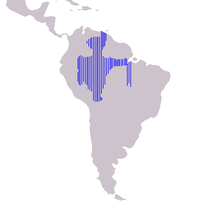Boto
|
|
| Boto Conservation status: Vulnerable | ||||||||||||||||||
|---|---|---|---|---|---|---|---|---|---|---|---|---|---|---|---|---|---|---|
| Scientific classification | ||||||||||||||||||
| ||||||||||||||||||
| Binomial name | ||||||||||||||||||
| Inia geoffrensis | ||||||||||||||||||
 Boto range |
The Boto, or Amazon River Dolphin (Inia geoffrensis) is a freshwater or river dolphin. It is endemic to the Amazon River and Orinoco River systems. The Boto is the largest of the river dolphins.
The IUCN lists Amazon Dolphin, Boto Vermelho, Bouto, Bufeo, Dauphin de l'Amazone, Inia, Pink Dolphin, Pink Freshwater Dolphin, Pink Porpoise, and Tonina as other names used to describe this species.
| Contents |
Taxonomy
The first type specimen was described by Henri Marie Ducrotay de Blainville in 1817.
Rice's 1998 classification lists a single species, I. geoffrensis, in the genus Inia, with three recognised subspecies:
- I.g. geoffrensis - Amazon basin population (excluding Madeira river drainage area, above the Teotonio Rapids in Bolivia)
- I.g. boliviensis - Amazon basin population in the Madeira drainage area
- I.g. humboldtiana - Orinoco basin population
Some older classifications listed the boliviensis population as a separate species.
Physical description
The boto can vary in colour from a memorable bright pink colour through to a murky brown, grey, or creamy white. Adults are typically 2.5 m in length and weigh 150 kg. The flippers are large compared with body size and are curved back. The boto does not have a dorsal fin, though a bumpy raised ridge on the back shows the evolutionary remnants of one. It has a prominent, long, thin beak with 25-35 pairs of teeth in both the upper and lower jaws. The front teeth are peglike, whereas the rear teeth are flatter with cusps. The two tooth types serve different functions: seizing prey and crushing, respectively. Botos generally feed from the bottom of the river and their preferred diet consists of crabs and small fish. Small turtles are also occasionally eaten.
This species is not often seen in groups larger than 2, but in rare circumstances up to 20 may be seen together. They are animals that are able to move their head in any direction, which is due to the unfused vertebrae in the neck. Though their eyes are small they can see quite well, except for their bulging cheeks hampering downward view. This, however, is overcome by swimming upside-down.
Conservation
By the precarious standards of the river dolphins, the boto is the most secure species in the superfamily. Nevertheless, the 1994 and 2000 IUCN Red List of Threatened Species classified it as vulnerable. In contrast to the rapidly dwindling areas of population of the Baiji and the Ganges and Indus River Dolphin, the area populated by the boto seems to have remained fairly steady over time. Although complete surveys have not been taken owing to the inaccessibility of the rainforests, it is estimated that the total population of botos runs into tens of thousands.
Botos have never been directly hunted. However fishermen are known to have occasionally killed them to protect their catch and fishing gear. It is not known whether this practice is widespread enough to damage local subpopulations. Since 1988 this practice has been outlawed in Brazil and Bolivia and in protected areas of Peru, Venezuela and Colombia.
The rising human population in the Amazon and Orinoco basins gives scientists cause for concern. Several damming projects of the kind that have devastated populations in Asia have been proposed for the region. Environmentalists will be vigorously opposed to such schemes.
Some boto deaths occur to mercury poisoning of their environment. These deaths typically occur close to gold mines; mercury is widely used to separate gold from surrounding rock.
Clipart and Animal Pictures
- Clipart (https://classroomclipart.com/image/category/clipart.htm)
- Animal Clipart (https://classroomclipart.com/image/category/animal-clipart.htm)
- Animal Animated Clipart (https://classroomclipart.com/clipart/Animations/Animals.htm)
- Pictures of Animals (https://classroomclipart.com/image/category/animal-photos.htm)
- Amphibian Clip Art, Pictures and Photogaphs (https://classroomclipart.com/image/category/amphibian-clipart.htm)
- Farm Animal Clip Art, Pictures and Photographs (https://classroomclipart.com/image/category/farm-animal-clipart.htm)
- Mammal Clip Art, Pictures and Photographs (https://classroomclipart.com/image/category/mammal-clipart.htm)
- Marine Animal Clip Art, Pictures and Photographs (https://classroomclipart.com/image/category/marine-life-clipart.htm)
- Reptile Clip Art, Pictures and Photographs (https://classroomclipart.com/image/category/reptile-clipart.htm)
- Spider Clip Art, Pictures and Photographs (https://classroomclipart.com/image/category/spider-clipart.htm)
References
- Rice, Dale W. (1998). Marine mammals of the world: systematics and distribution. Society of Marine Mammalogy Special Publication Number 4. 231 pp.
External links
- Dolphins, Whales and Porpoises: 2002–2010 Conservation Action Plan for the World's Cetaceans. IUCN/SSC Cetacean Specialist Group 2003, Reeves et al. Report in PDF format (2Mb) (http://www.iucn.org/themes/ssc/actionplans/cetaceans/cetaceans.pdf)
- Convention on Migratory Species page on the Amazon Dolphin (http://www.wcmc.org.uk/cms/reports/small_cetaceans/data/I_geoffrensis/I_geoffrensis.htm)
- Walker's Mammals of the World Online - Amazon Dolphins (http://www.press.jhu.edu/books/walkers_mammals_of_the_world/cetacea/cetacea.iniidae.inia.html)
- Animal Info page on the Boto (http://www.animalinfo.org/species/cetacean/iniageof.htm)
- Cetacea.org page on the Boto (http://www.cetacea.org/boto.htm)

